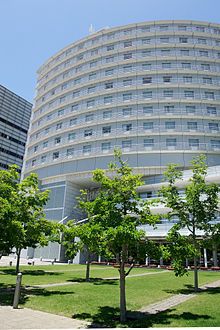Japan International Cooperation Agency
This article needs additional citations for verification. (April 2018) |
 | |
| Abbreviation | JICA |
|---|---|
| Formation | August 1, 2003 |
| Type | Incorporated Administrative Agency |
| Legal status | Active |
| Purpose | Official development assistance |
| Headquarters | 1F–6F Ninbancho Building Center, Chiyoda, Tokyo, Japan |
Region served | Worldwide |
Official language | Japanese English (secondary) |
President | Akihiko Tanaka |
| Affiliations | Development Assistance Committee Organisation for Economic Co-operation and Development |
Budget | ¥1.478 billion |
| Staff | 1,845 (March 2015) |
| Website | jica.go.jp |


The Japan International Cooperation Agency (Japanese: 独立行政法人国際協力機構, romanized: dokuritsu gyōseihōjin kokusai kyōryoku kikō), also known as JICA, is a governmental agency that delivers the bulk of Official Development Assistance (ODA) for the government of Japan. It is chartered with assisting economic and social growth in developing countries and promoting international cooperation. According to the OECD, Japan's total official development assistance (ODA) (US$17.5 billion, grant-equivalent methodology, preliminary data) increased in 2022 due to an increase in its bilateral lending, which included support to Ukraine. ODA represented 0.39% of gross national income (GNI).[1] The OECD's Development Assistance Committee published a peer review of Japan's development cooperation in October 2020.[1] JICA was led by Shinichi Kitaoka, the former President of the International University of Japan, from 2015 to 2022. On 1 April 2022, Professor Akihiko Tanaka assumed the presidency.[2]
History
[edit]JICA was formed in 2003[citation needed] as a result of a comprehensive overhaul of Japan's ODA. It is now one of the largest bilateral development organizations in the world, with a network of 97 overseas offices, projects in more than 150 countries, and available financial resources of approximately 1 trillion yen ($8.5 billion).[citation needed] JICA is responsible for administering Japan's grant aid, providing technical cooperation and concessional loans to developing countries, strengthening collaboration with international institutions, and contributing to global development strategies.
JICA has undergone an operational and organizational change in its country offices, placing greater emphasis on a field-based approach to programs/projects, decentralizing staff, and delegating increased authority from Tokyo headquarters to overseas offices, reducing bureaucracy, and fast-tracking programs/projects.[citation needed]
JICA's focus has shifted towards providing "human security" to local communities by strengthening grassroots programs, such as improving education and health projects.[citation needed]
Timeline
[edit]- 1954 Apr - Japan joined the Colombo Plan and initiated technical cooperation programs
- 1962 Jun - Overseas Technology Cooperation Agency (OTCA) established
- 1963 Jul - Japan Emigration Service (JEMIS) established
- 1965 Apr - Japan Overseas Cooperation Volunteers (JOCV) program launched
- 1974 Aug - OTCA and JEMIS merge to form the Japan International Cooperation Agency (JICA)
- 1987 Sep - Disaster Relief Team formed
- 1989 - Total official development assistance (ODA) contributions exceed that of the United States to become the highest in the world
- 1990 Apr - Senior Cooperation Specialist (Senior Overseas Volunteer) dispatch program begun
- 2003 Oct - JICA established as an Independent Administrative Institution
Presidents
[edit]JICA's current and former presidents:[3]
- since 1 April 2022: Akihiko Tanaka
- 1 October 2015 – 31 March 2022: Shinichi Kataoka
- 30 March 2012 – 1 October 2015: Akihiko Tanaka
- 1 October 2003 – 30 March 2012: Sadako Ogata
Activities
[edit]JICA is part of Japan's official development assistance effort, with a role in providing technical cooperation, capital grants and yen loans. According to the OECD, official development assistance from Japan increased by 1.2% to US$16.3 billion in 2020.[1] JICA's core development programs (aid modalities) are technical assistance programs/projects for capacity and institutional development, feasibility studies and master plans, and dispatching specialists.[citation needed] The Japan Overseas Cooperation Volunteers (JOCV), JICA Senior Volunteers, and Japan Disaster Relief Team groups of JICA are widely known among the Japanese general public.[citation needed] Japan Disaster Relief Team members are often seen in news reports on relief efforts after major natural disasters around the world, such as the 2005 South Asian earthquake.[citation needed]
Specialists dispatched to the field include those recommended from related government ministries and agencies as well as those applying through the specialist registration system. Such assignments can last for more than a year.[citation needed]
Technical training program
[edit]JICA provides technical training for participants from developing countries in a wide range of fields, including medical, industrial, and agricultural training. This includes field-specific courses, which vary in length from three weeks to one year; country/region-specific courses; and individual training. JICA maintains International Centers in major Japanese cities, which serve as accommodation facilities for many of its programs.[citation needed]
Volunteer dispatch
[edit]- Japan (Youth) Overseas Cooperation Volunteers (JOCV)
- Senior Overseas Volunteers[citation needed]
- Nikkei Society Youth Volunteers[citation needed]
- Nikkei Society Senior Volunteers[citation needed]
See also
[edit]References
[edit]- ^ a b c "Japan | Development Co-operation Profiles – Japan | OECD iLibrary".
- ^ "TANAKA Akihiko becomes JICA's new president | News | News & Features | JICA". www.jica.go.jp. Retrieved 2023-06-28.
- ^ Former President's Visits & Remarks, JICA
External links
[edit]- (in English) JICA official website in English
- (in Japanese) JICA official website in Japanese
- Japan Ministry of Foreign Affairs ODA webpage
- (in Japanese) JICA Japan Overseas Migration Museum website

